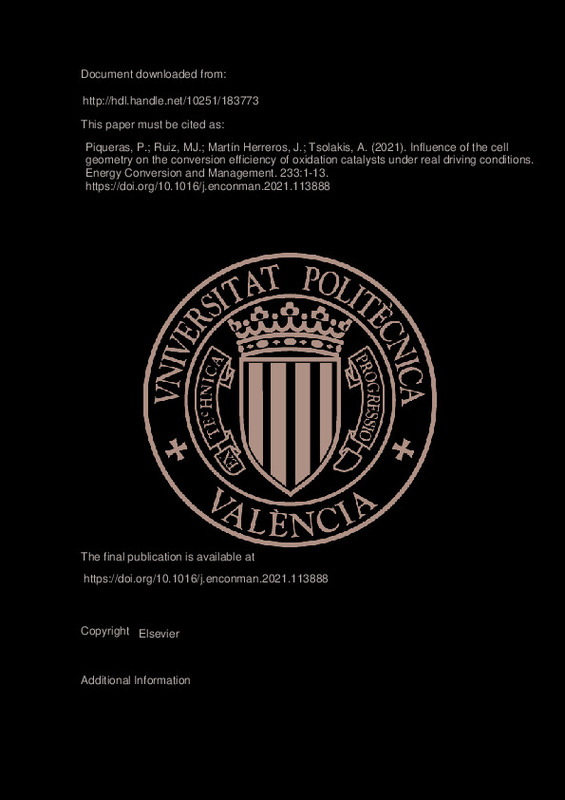JavaScript is disabled for your browser. Some features of this site may not work without it.
Buscar en RiuNet
Listar
Mi cuenta
Estadísticas
Ayuda RiuNet
Admin. UPV
Influence of the cell geometry on the conversion efficiency of oxidation catalysts under real driving conditions
Mostrar el registro sencillo del ítem
Ficheros en el ítem
| dc.contributor.author | Piqueras, P.
|
es_ES |
| dc.contributor.author | Ruiz, María José
|
es_ES |
| dc.contributor.author | Martín Herreros, José
|
es_ES |
| dc.contributor.author | Tsolakis, Athanasios
|
es_ES |
| dc.date.accessioned | 2022-07-01T18:04:06Z | |
| dc.date.available | 2022-07-01T18:04:06Z | |
| dc.date.issued | 2021-04-01 | es_ES |
| dc.identifier.issn | 0196-8904 | es_ES |
| dc.identifier.uri | http://hdl.handle.net/10251/183773 | |
| dc.description.abstract | [EN] Worldwide pollutant regulations applied to the transportation sector are progressively tightening the emission limits and widening the operating conditions of the type approval tests. As a result, the layout and thermal management of the exhaust system is becoming highly complex looking to achieve early catalytic converter activation. On this regard, the monolith meso-geometry plays a primary role to optimise the pollutants con -version efficiency. The geometrical characteristics simultaneously affect and trade-off multiple flow phenomena as the exhaust gas is transported through the channels. These include the bulk gas and internal pore diffusion towards the active sites in addition to the heat transfer including convection, radial conductivity and thermal capacitance. In this work, the impacts of the cell size, cross-section shape, washcoat loading and substrate material on CO and HC conversion efficiency have been investigated under representative real driving condi-tions. From the real driving conditions experimental data, the study decouples the influence of the washcoat loading from the cell size and material applying a catalytic converter model. Detailed expressions are provided for the calculation of the specific surfaces and heat and mass transfer parameters as a function of the cell and washcoat meso-geometry in square and triangular cells. Therefore, this work enables to identify the processes which govern the catalytic abatement of pollutant emissions. In particular, the role of the gas and washcoat specific surfaces is highlighted because of its importance on the optimization of the mass transfer process by means of a proper cell geometry selection. In parallel, the differences in the change of the CO and HC abatement patterns, which are explained by the characteristic CO emission spikes in accelerations and the HC accumulation, contribute to evidence the limitations on the conversion efficiency benefit that the optimum cell geometry and washcoat loading can provide. | es_ES |
| dc.description.sponsorship | The authors acknowledge FEDER and Spanish Ministerio de Economia y Competitividad for partially supporting this research through project TRA2016-79185-R. Additionally, the Ph.D. student Maria Jose Ruiz has been funded by a grant from Universitat Politecnica de Valencia with reference number FPI-2018-S2-10. | es_ES |
| dc.language | Inglés | es_ES |
| dc.publisher | Elsevier | es_ES |
| dc.relation.ispartof | Energy Conversion and Management | es_ES |
| dc.rights | Reconocimiento - No comercial - Sin obra derivada (by-nc-nd) | es_ES |
| dc.subject | Catalytic converter | es_ES |
| dc.subject | Internal combustion engine | es_ES |
| dc.subject | Emissions | es_ES |
| dc.subject | Cell geometry | es_ES |
| dc.subject | Conversion efficiency | es_ES |
| dc.subject | Driving cycle | es_ES |
| dc.subject.classification | MAQUINAS Y MOTORES TERMICOS | es_ES |
| dc.title | Influence of the cell geometry on the conversion efficiency of oxidation catalysts under real driving conditions | es_ES |
| dc.type | Artículo | es_ES |
| dc.identifier.doi | 10.1016/j.enconman.2021.113888 | es_ES |
| dc.relation.projectID | info:eu-repo/grantAgreement/UPV//FPI-2018-S2-10/ | es_ES |
| dc.relation.projectID | info:eu-repo/grantAgreement/AGENCIA ESTATAL DE INVESTIGACION//TRA2016-79185-R//DESARROLLO DE HERRAMIENTAS EXPERIMENTALES Y COMPUTACIONALES PARA LA CARACTERIZACION DE SISTEMAS DE POST-TRATAMIENTO DE GASES DE ESCAPE EN MOTORES DE ENCENDIDO POR COMPRESION/ | es_ES |
| dc.rights.accessRights | Abierto | es_ES |
| dc.contributor.affiliation | Universitat Politècnica de València. Departamento de Máquinas y Motores Térmicos - Departament de Màquines i Motors Tèrmics | es_ES |
| dc.description.bibliographicCitation | Piqueras, P.; Ruiz, MJ.; Martín Herreros, J.; Tsolakis, A. (2021). Influence of the cell geometry on the conversion efficiency of oxidation catalysts under real driving conditions. Energy Conversion and Management. 233:1-13. https://doi.org/10.1016/j.enconman.2021.113888 | es_ES |
| dc.description.accrualMethod | S | es_ES |
| dc.relation.publisherversion | https://doi.org/10.1016/j.enconman.2021.113888 | es_ES |
| dc.description.upvformatpinicio | 1 | es_ES |
| dc.description.upvformatpfin | 13 | es_ES |
| dc.type.version | info:eu-repo/semantics/publishedVersion | es_ES |
| dc.description.volume | 233 | es_ES |
| dc.relation.pasarela | S\435778 | es_ES |
| dc.contributor.funder | AGENCIA ESTATAL DE INVESTIGACION | es_ES |
| dc.contributor.funder | European Regional Development Fund | es_ES |
| dc.contributor.funder | Universitat Politècnica de València | es_ES |







![[Cerrado]](/themes/UPV/images/candado.png)

